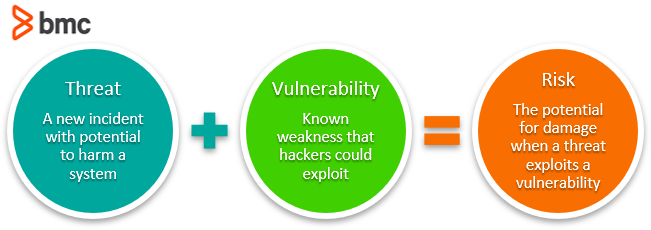IT Security Vulnerability vs Threat vs Risk: What are the Differences?


In today’s world, data and protecting that data are critical considerations for businesses. Customers want to ensure that their information is secure with you, and if you can’t keep it safe, you will lose their business. Many clients with sensitive information actually demand that you have a rigid data security infrastructure in place before doing business with you.
With that backdrop, how confident are you when it comes to your organization’s IT security?
In order to have a strong handle on data security issues that may potentially impact your business, it is imperative to understand the relationships of three components:
Though these technical terms are used interchangeably, they are distinct terms with different meanings and implications. Let's take a look.
 (This article is part of our Security & Compliance Guide. Use the right-hand menu to navigate.)
(This article is part of our Security & Compliance Guide. Use the right-hand menu to navigate.)
David Cramer, VP and GM of Security Operations at BMC Software, explains:
A threat refers to a new or newly discovered incident that has the potential to harm a system or your company overall. There are three main types of threats:
Worms and viruses are categorized as threats because they could cause harm to your organization through exposure to an automated attack, as opposed to one perpetrated by humans. Most recently, on May 12, 2017, the WannaCry Ransomware Attack began bombarding computers and networks across the globe and has since been described as the biggest attack of its kind. Cyber criminals are constantly coming up with creative new ways to compromise your data, as seen in the 2017 Internet Security Threat Report.
These threats may be uncontrollable and often difficult or impossible to identify in advance. Still, certain measures help you assess threats regularly, so you can be better prepared when a situation does happen. Here are some ways to do so:
A vulnerability refers to a known weakness of an asset (resource) that can be exploited by one or more attackers. In other words, it is a known issue that allows an attack to succeed.
For example, when a team member resigns and you forget to disable their access to external accounts, change logins, or remove their names from company credit cards, this leaves your business open to both intentional and unintentional threats. However, most vulnerabilities are exploited by automated attackers and not a human typing on the other side of the network.
Testing for vulnerabilities is critical to ensuring the continued security of your systems. By identifying weak points, you can develop a strategy for quick response. Here are some questions to ask when determining your security vulnerabilities:
Understanding your vulnerabilities is the first step to managing your risk. (Learn more about vulnerability management.)
Risk is defined as the potential for loss or damage when a threat exploits a vulnerability. Examples of risk include:
Risk can also be defined as:
Risk = Threat x Vulnerability
Reduce your potential for risk by creating and implementing a risk management plan. Here are the key aspects to consider when developing your risk management strategy:
To summarize the concepts of threat, vulnerability, and risk, let’s use the real-world example of a hurricane.
![]() The threat of a hurricane is outside of one’s control. However, knowing that a hurricane could strike can help business owners assess weak points and develop an action plan to minimize the impact. In this scenario, a vulnerability would be not having a data recovery plan in place in the event that your physical assets are damaged as a result of the hurricane. The risk to your business would be the loss of information or a disruption in business as a result of not addressing your vulnerabilities.
The threat of a hurricane is outside of one’s control. However, knowing that a hurricane could strike can help business owners assess weak points and develop an action plan to minimize the impact. In this scenario, a vulnerability would be not having a data recovery plan in place in the event that your physical assets are damaged as a result of the hurricane. The risk to your business would be the loss of information or a disruption in business as a result of not addressing your vulnerabilities.
Accurately understanding the definitions of these security components will help you to be more effective in designing a framework to identify potential threats, uncover and address your vulnerabilities in order to mitigate risk.
For related reading, explore these resources: